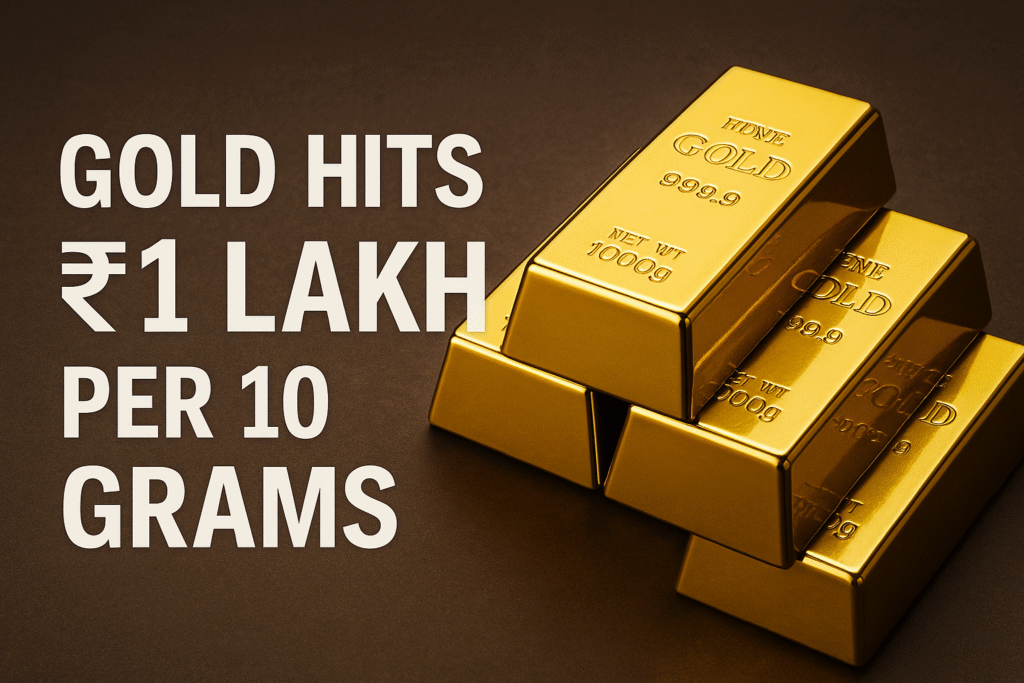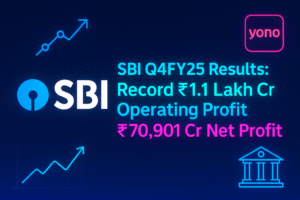
In a historic move, gold prices in India have crossed the ₹1,00,000 mark per 10 grams for the first time ever. This remarkable milestone, achieved on April 22, 2025, reflects a combination of global economic factors, increased investor interest in safe-haven assets, and seasonal demand trends in domestic markets.
This article explores the key reasons behind the rally, its implications for investors, and whether this is a short-term peak or the beginning of a new era for the precious metal.
The Price Movement: From ₹96,670 to ₹1 Lakh in 24 Hours
The gold rally accelerated sharply in the past 24 hours, with the price of 24K gold rising from ₹96,670 to ₹1,00,000 per 10 grams in major Indian cities, including Mumbai and Delhi. Futures contracts on the Multi Commodity Exchange (MCX) also hit ₹1,00,000 for August delivery. This spike follows a strong uptrend observed since the beginning of the year.
Key Factors Behind the Price Surge
1. Global Economic Uncertainty
Geopolitical tensions and fears of a prolonged economic slowdown have pushed investors towards gold. Recent developments in the US-China trade relationship, including aggressive tariffs on goods, have shaken market sentiment and revived demand for gold as a stable investment.
2. Weakness in the US Dollar
A softening dollar makes gold more attractive globally. The recent decline in the dollar index has further driven demand among international investors, indirectly impacting Indian prices due to import dependency.
3. Federal Reserve’s Interest Rate Policy
With increasing expectations of rate cuts from the US Federal Reserve, investors are hedging against potential inflation and currency depreciation. Lower interest rates typically reduce the opportunity cost of holding gold, boosting demand.
4. Central Bank Accumulation
Several global central banks, including those of China and Turkey, have increased their gold reserves in the past year. This long-term positioning supports the price stability and upward trend of gold.
5. Domestic Seasonal Demand
The price surge comes just ahead of Akshaya Tritiya, a major gold-buying festival in India. With cultural and religious importance attached to gold purchases during this time, consumer demand has spiked, further adding to the momentum.
Investment Perspective: Is It Too Late to Buy?
Analysts remain divided on whether the current rally will sustain or see a correction.
Some believe that prices may continue to climb, especially if geopolitical risks escalate or inflation expectations rise. Analysts at Motilal Oswal suggest gold could reach ₹1,06,000 in the coming months. On the other hand, some advise caution, recommending profit booking and staggered investments rather than lump sum entries at current levels.
Investors must also factor in that gold has already given over 20% returns in 2025, and the pace of growth may moderate in the near term.
Lessons from the Past: Gold as a Long-Term Hedge
In less than three years, gold prices in India have doubled—from ₹50,000 per 10 grams in October 2022 to ₹1,00,000 in April 2025. This reinforces gold’s traditional role as a hedge against inflation, market volatility, and currency devaluation.
For long-term investors, especially those looking for portfolio diversification, gold continues to be a reliable store of value.
City-Wise Gold Prices (24K Gold per 10g) – April 22, 2025
| City | Price (INR) |
|---|---|
| Mumbai | ₹1,00,000 |
| Delhi | ₹99,800 |
| Chennai | ₹99,500 |
| Kolkata | ₹99,700 |
| Bengaluru | ₹99,600 |
Note: Prices are indicative and may vary by jeweller and region.
Conclusion: Caution and Opportunity
While the milestone of ₹1 lakh per 10 grams is symbolic and historic, investors must look beyond the headlines. The fundamentals still favor gold, but volatility at these elevated levels cannot be ruled out.
As with all investments, gold too demands strategic thinking. Those with a long-term horizon may continue to accumulate gradually, while short-term traders should watch global cues closely.
Source: Times of India, Moneycontrol, Livemint, Economic Times, MCX India
Disclaimer:
The information provided in this article is for informational and educational purposes only and should not be construed as investment advice. Readers are advised to consult with a qualified financial advisor before making any investment decisions. Paisonomics does not guarantee the accuracy or completeness of any information contained herein and shall not be held liable for any losses or damages arising from the use of this content.



